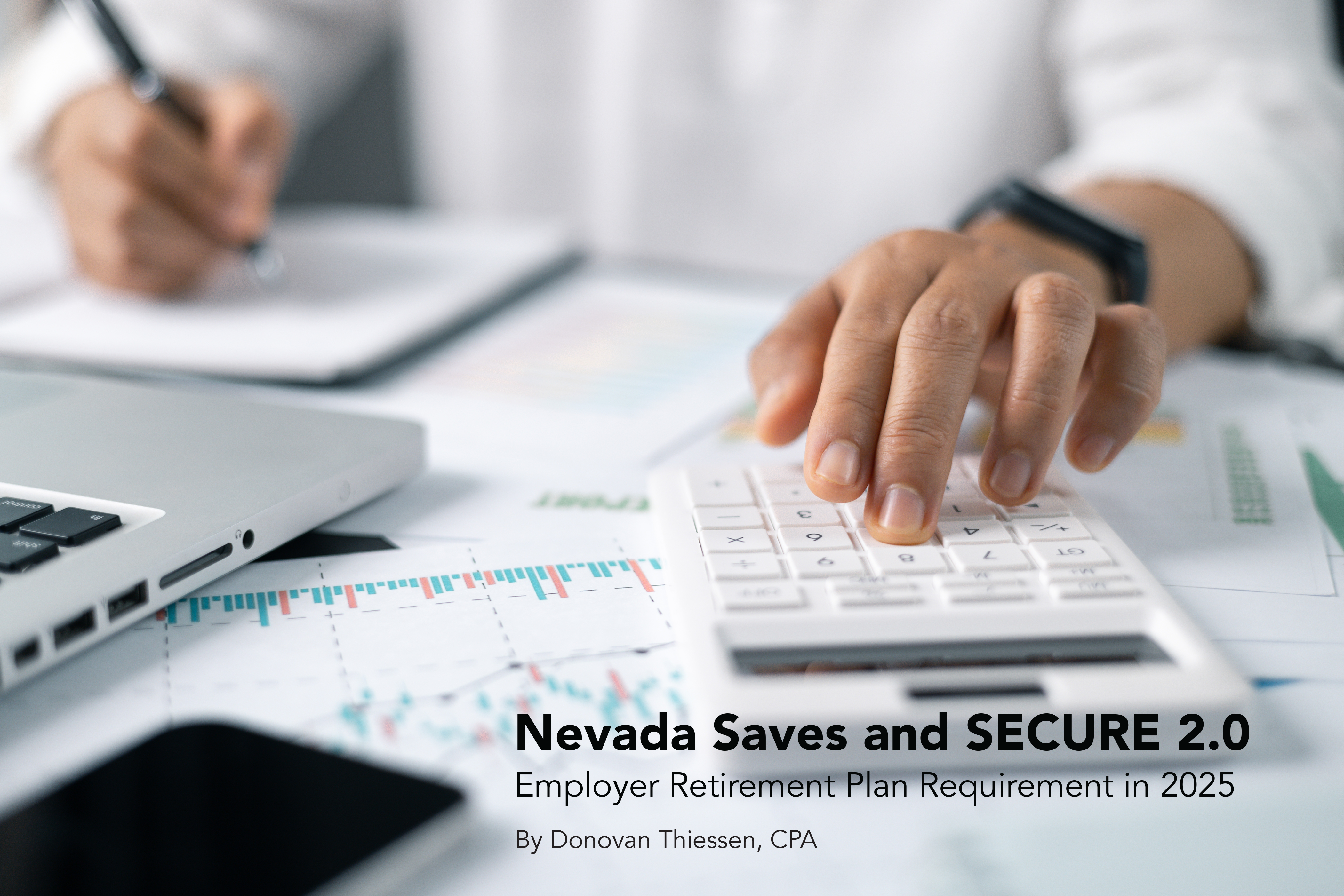 Starting July 1, 2025, Nevada business owners will face a new requirement: the Nevada Saves program. This state-mandated retirement savings initiative could reshape how you offer employee benefits. Alongside this state-level change, the federal SECURE 2.0 Act is already in effect, bringing additional opportunities and considerations for your retirement planning strategy. We’ll explore Nevada Saves’ benefits, compliance requirements, and the tax credits available through SECURE 2.0. We’ll also review alternative retirement plan options and clarify whether Nevada Saves applies to your business as of July 1, 2025. By the end, you’ll better understand how these laws impact your business and the steps you can take to comply and maximize benefits.
Starting July 1, 2025, Nevada business owners will face a new requirement: the Nevada Saves program. This state-mandated retirement savings initiative could reshape how you offer employee benefits. Alongside this state-level change, the federal SECURE 2.0 Act is already in effect, bringing additional opportunities and considerations for your retirement planning strategy. We’ll explore Nevada Saves’ benefits, compliance requirements, and the tax credits available through SECURE 2.0. We’ll also review alternative retirement plan options and clarify whether Nevada Saves applies to your business as of July 1, 2025. By the end, you’ll better understand how these laws impact your business and the steps you can take to comply and maximize benefits.
The Nevada Employee Savings Trust Program, also called Nevada Saves, is a state-mandated retirement savings initiative designed to tackle a pressing issue: many small businesses in Nevada don’t offer retirement plans, leaving workers without straightforward ways to save. Enacted in 2023 with Nevada Senate Bill 305, it is scheduled to become effective starting July 1, 2025. Private sector for-profit and non-profit companies with more than five employees at any time within the current calendar year or prior three calendar years must join the program if they lack a qualified retirement plan, such as a 401(k) or pension. It’s Nevada’s effort to ensure employees can secure their financial futures.
The program features automatic enrollment, meaning eligible employees will have contributions deducted from their paychecks into individual retirement accounts (IRAs) unless they opt-out. Covered employees must be given at least 90 days to opt out after being automatically enrolled. This setup promotes savings while keeping options open. Whether these IRAs will be Roth or traditional is still under review, but the goal is to streamline retirement planning.
If your business employs more than five people and doesn’t have a qualified retirement plan, Nevada Saves applies to you, you should begin looking at your options. The implementation start date is July 1, but the Board has not yet established a program so that covered employees can start making contributions by then. Employer deadlines have yet to be set by the board, such as how many days you have to register and enroll employees once the business becomes covered. It is expected that the board will provide direct communications to covered employers between now and then that will cover the registration instructions, compliance deadlines, and the opt-out process if you offer an existing retirement plan.
 In the meantime, if you are an employer that already has a retirement plan for your employees, or your business is less than 36 months old, or you have 5 or fewer employees, then you do not need to participate in the Nevada Saves program. For employers that adopt a new retirement plan or if you’ve recently adopted a plan, there is some relief on the related expenses from the Federal level in the form of income tax credits.
In the meantime, if you are an employer that already has a retirement plan for your employees, or your business is less than 36 months old, or you have 5 or fewer employees, then you do not need to participate in the Nevada Saves program. For employers that adopt a new retirement plan or if you’ve recently adopted a plan, there is some relief on the related expenses from the Federal level in the form of income tax credits.
The SECURE 2.0 Act of 2022 provides federal incentives for adopting an employer-sponsored retirement plan. For businesses with up to 50 employees, a startup cost credit covers 100% of eligible expenses—such as plan setup and administration to $5,000 per year for three years, totaling a potential of $15,000. This depends on the number of non-highly compensated employees who can participate.
If you add automatic enrollment to your plan, you can claim an additional $500 per year for three years. Since Nevada Saves has an automatic enrollment feature for covered employees, this tax credit immediately applies.
For example, if your 20-employee business spends $4,000 to establish a 401(k), you could claim a $4,000 tax credit in the first year, plus $500 for auto-enrollment—lowering your tax liability directly. These credits are available each of the first three years of the plan’s life. These credits reduce your tax liability dollar for dollar.
Nevada Saves emerges amid significant shifts. With people living longer and Social Security’s future uncertain, robust retirement savings are more critical than ever. Small businesses, a cornerstone of Nevada’s economy, often lack the resources for plans. This program mandates participation, ensuring more workers build savings. According to AARP, 296,000 out of 593,000 (as of 2023) do not have access to retirement savings plans through their employers.
The SECURE 2.0 Act complements the Nevada Saves program by delaying required minimum distributions (RMDs) to age 73 (and 75 by 2033), allowing tax-deferred savings to grow longer. Together, they create a strong retirement foundation.
Nevada Saves is one path, but other options are worth considering:
401(k) Plan: Employees contribute through payroll, often with employer matches. Many now include Roth options, where assets grow tax-free.
SEP IRA: Easy to set up and perfect for small firms (especially good for self-employed individuals) funded solely by the employer. Beware that this plan could be cost-prohibitive as the funding percentage must be the same for all employees that have been employed for three years.
SIMPLE IRA: A simpler alternative to a 401(k) for businesses under 100 employees, requiring employer contributions.
Pension Plans: Provide fixed benefits in retirement, though they’re costlier and less common today.
As of this writing, the Nevada Employee Savings Trust website has limited information and functionality. Simply search for it on your web browser and it will be among the first to be listed. We expect more details soon as July 1 is only a few months away. The Nevada Saves official website, expected to launch closer to July 1, 2025, will offer guides and FAQs. Nevada Saves is more than a requirement, it’s an opportunity to support your team and business. Get to know the program, take advantage of SECURE 2.0, and explore your options. Consult your tax or financial advisor for guidance tailored to your circumstances.
Not sure how to begin? Donovan Thiessen, CPA, at The Accountant, LLC (donovan@theaccountantcpa.com, 702.389.2727), can offer personalized advice on compliance, credits, and tax planning strategies.

Leave a Comment